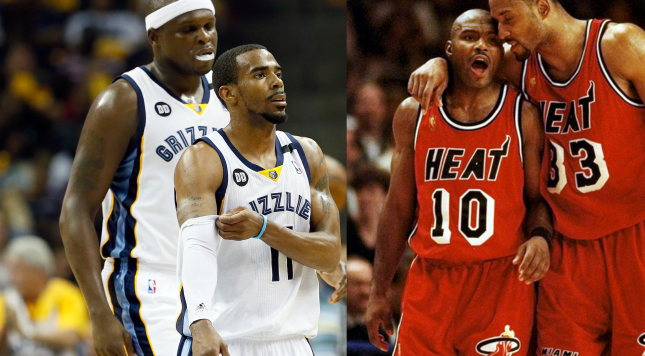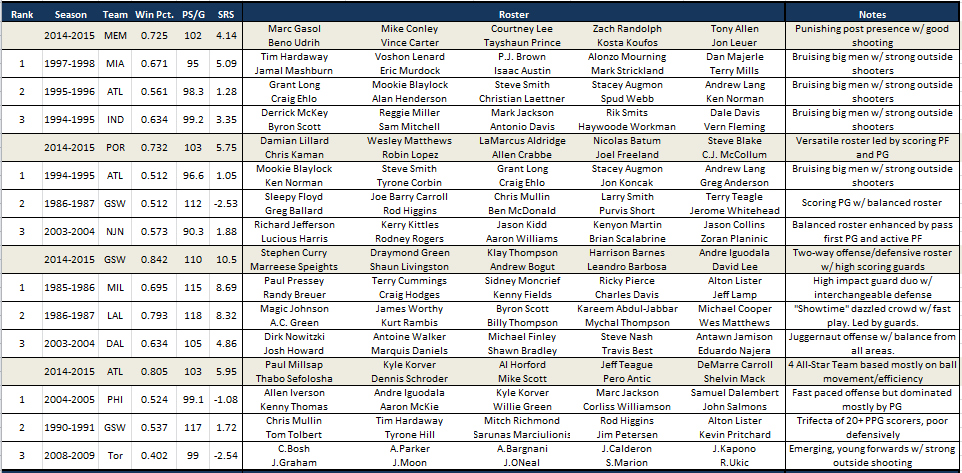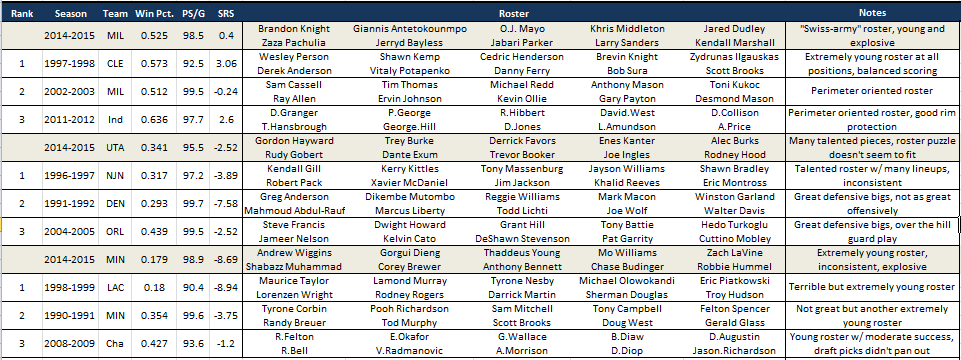One of the main debates concerning the game of basketball and the NBA revolves around how teams compare to others in history. We often ask ourselves; has there been a team like the 90s Chicago Bulls? Showtime Lakers? Bird Celtics? Shaq-Kobe Lakers? These questions are all great thought experiments but ultimately very difficult to objectively answer since we have to consider the era in which they played, team context, coaching, and other hard to control factors.
Using an extensive search algorithm, an attempt was made to compare selected teams in the 2014-2015 NBA season to their “doppelgangers” (or teams they most closely resemble accounting for the factors mentioned above). While the results follow intuitively from what we have seen from these teams thus far, the season is only halfway through so teams may not necessarily be performing at their peak levels. Nevertheless, the algorithm accounts for total output at each position along with averages for that season. Thus if a particular season saw a noticeably larger improvement in the play of centers, this would be accounted for in determining a player’s value (similar to the concept of wins above replacement). Lastly, no subjective measures of determining a player’s value were used. For instance, unlike many of the metrics popularized in the media, I did not arbitrarily assign value to statistics based on what I “thought” was reasonable but rather through the use of econometric techniques aimed to objectively quantify statistics that best predict wins.
The teams selected for this analysis were chosen based off of the criteria that they have had few injuries (their samples contain truer representations), and are teams favored to win the title or those on the other end of the spectrum; teams with potentially talented rosters but poor performance this season. Considering that we are only halfway through the season, these results may change as trades happen (as we have recently seen), injuries accumulate, or performance improves.
The Regular Season Contenders
Like all teams in NBA history, each one possesses a unique style with strengths and weaknesses to match. Teams in this category are currently having great seasons yet many questions about how they will fare in the playoffs remain unanswered. The results below show the 3 closest historical doppelgangers the algorithm returned for these teams.
Based on their records, the Memphis Grizzlies, Portland Trailblazers, Golden State Warriors, and Atlanta Hawks are currently considered, to some extent, favorites to win the title. They, however; share the same quality of having been bounced out of the playoffs in the fairly early stages last year and thus need to “prove” themselves on that level. Without question, they are great regular season teams and many of their closest matches were as well. Within those top 3 matches, we see that the Memphis Grizzlies, Portland Trailblazers, and Golden State Warriors all compare to teams who made it to the NBA finals in their respective seasons with all of the top comparisons showing an above .500 winning percentage in the regular season. You can take what you like from the results shown in terms of playing style and roster construction (the notes help!) but the fact remains that all of these teams should be considered legitimate candidates to make the NBA finals based on the teams they resemble in the past.
Unlike the three previous teams, the Atlanta Hawks closest matches compare least favorably to history. That is not to say that they are an overachieving team but perhaps that they may regress over the second half of the season. Also, a more team-centric approach to the game of basketball has been popularized so perhaps they compare unfavorably to history since their approach to basketball is a relatively newer trend.
The down but not outs
The Clippers and Spurs were selected for this category because of their noticeably lower level of play compared to seasons past. As we all know, these teams have proven their playoff resolve so an analysis of what they have currently placed on the floor might prove useful to temper (or bolster) expectations.
Interestingly enough, the Clippers and Spurs actually look much like last year’s iterations of themselves. This makes sense given that they have had limited roster turnover. They also compare well to historically great teams (more so for the Clips) so people who may be counting these teams out should not do so just yet. While it is fair to say that they have not looked like their usual dominant selves, they are certainly no pushovers and will be truly in the mix come playoff time. Many forget that the regular season is more of a marathon than a sprint so a few losses in a row shouldn’t be cause for panic. In fact, I would argue that a bit of adversity in the regular season is better for a contending team in the long run.
Up and Comers
In the NBA, much is made about “potential” and how teams with young rosters will play out in the future. These teams are often the hardest to predict since rosters rarely stay fixed and player development is the main influence. More than anything, the purpose of the following results will show teams who have had historically similar situations which we can then trace back to what went well or wrong with each team. In other words, if a current team compares closely to a previous team that was once considered to be an “up and comer,” we can perhaps look back and identify reasons for their success or failure as a franchise in order to make better decisions.
Intuitively, teams who are currently having bad seasons have doppelgangers that have also had bad seasons. Even though the ages of the roster in question were not accounted for, all of the teams analyzed compared very closely to historically young (and losing) rosters. This demonstrates the strength of the algorithm in matching production and qualities of players. Without diving into specific detail about the rosters shown for these teams, notes have been provided that describe playing style and team context for the team shown.
Obviously, showing the results for the 30 NBA teams in question would have been a test of your resolve in looking at tables. For the sake of this analysis, I limited the findings to teams who I thought would be interesting case studies; however, I can make results available for any team that has played since 1985 and extend their top 3 doppelgangers to top 20 if anyone was so inclined to see. So if your favorite team was the 2000 Vancouver Grizzlies, comparisons for them using the search algorithm are available. Had I entered the relevant statistics for the 1990s Chicago Bulls, the algorithm would have returned the closest doppelgangers to that team and now at least provided a basis of comparison where we can then pointlessly argue about the best team ever. An article is at least currently in the works regarding those teams.
Any questions about the method (or if you want to just talk basketball) can be addressed to the twitter handle @chrisbizzzle or e-mail: christopher.gonzalez@duke.edu.























